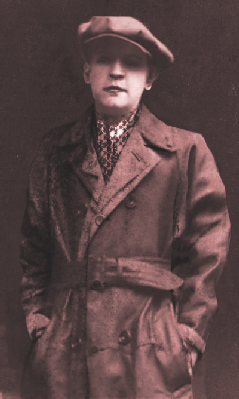

 Extract from the final address to the jury by the Counsel
appearing for Mr. Alexander Calder in the Calder v Moore trial,
April 1954.
Extract from the final address to the jury by the Counsel
appearing for Mr. Alexander Calder in the Calder v Moore trial,
April 1954.Members of the Jury; we have a problem - a significant ethical and legal problem. As you are aware, this is an action for sexual deviancy, fraudulent misrepresentation and defamation of character brought against Marie Lynette Moore, also known as James Scott Morrison. At stake is the reputation of my client, Mr. Alexander Calder, who was falsely and maliciously portrayed in a family portrait commissioned from the accused in February 1953...
One is always able to detect the hand of the artist in every portrait. The portrait is, after all, the artist's own interpretation of the subject he is painting. Surely, it follows that when the real nature of the artist is revealed to be different to that which was assumed by the subject at the time of the sitting, then those earlier interpretations attributed by the sitter on the part of the artist are shown to be invalid. His original judgement is mistaken and a new set of interpretations must be applied. As the artist's true nature is revealed to be unsound, so then the painting must be judged accordingly. The imprint of deceit and forgery transfers from one to the other, ladies and gentlemen. The artist is proved to be a deliberate fake and so, therefore, is his product.
 Portrait of the artist James Scott Morrison, Melbourne 1950 digital photograph on bromide 30 x 21cm
Portrait of the artist James Scott Morrison, Melbourne 1950 digital photograph on bromide 30 x 21cm
The trial of Marie Lynette Moore concerns the degree to which the meaning of a work depends upon the identity of the artist who created it--not just his or her standing in the art market, but their social identity. Gender, class, race, religion, sexuality--all the features that are silently reckoned when measuring our affinity with a work of art. What's left for aesthetic value once the die of artistic identity is cast? (D.P.)
Marie Lynette Moore (aka James Scott Morrison)
1922-1931 attends Cremorne Ladies College, Richmond.
1932-1935 studies Art (drawing, design, perspective, modelling), Prahran Technical School.
1935-37 works as freelance illustrator for East Suburban Newspapers Pty. Ltd. Does advertising and commercial art work, takes private art classes.
1938-45 travels to Great Britain and Europe to undertake independent study of the mastersHolbein, Rembrandt, Van Eyck, Daumier, Waterhouse. WW2 begins in Europe. Works as an illustrator with the War Department in London, illustrating pilot manuals and sketching injured servicemen and women in hospitals. Frequents Cafe Royale, a club in Regent Street. Takes the name of James Morrison; assumes the appearance and persona of a man, and lives publicly and privately as a man.
1945 returns to Australia. Begins affair with Louise Purdue, a court reporter.
1945-1950 works as freelance courtroom illustrator for The Herald . Begins making privately commissioned portraits for friends, relatives and courtroom acquaintances. Gains a certain underworld notoriety for retouched courtroom 'portraits'.
1950-1954 leaves The Herald and advertises as James Scott Morrison ~ Society Portraitist. Reputation builds by word of mouth and white-collar contacts. Establishes flourishing business specialising in masquerade or 'in character' portraiture.
May, 1953 paints The Calder Family, a portrait of Melbourne-based shipping magnate Mr. Alexander Calder posed as a Roman Emperor at home.
November, 1953 identified as a woman by Mrs. Alexander Calder. Mr. Calder begins litigation proceedings against Moore.
April, 1954 Calder v Moore trial begins. Marie Lynette Moore arraigned on three charges of sexual deviancy, fraudulent misrepresentation and defamation of character with malicious intent.
Text and work by Kate Reeves
| Back to the trial |